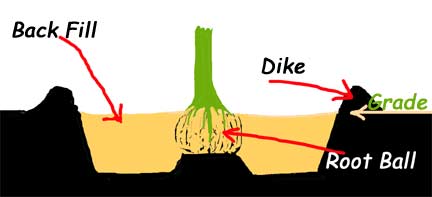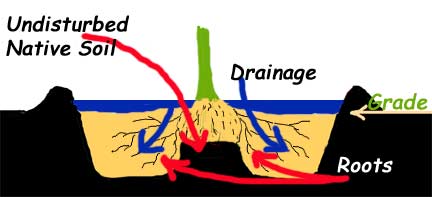|
As we increase the micro-organism
activity within the organic material, the direct results are
a faster decomposition process and at the same time increasing
the quantity of nitrates that are made available to the plants.
Organic amendments such as Peat moss, leaves, leaf mold,
well rotted *manure and/or compost, usually have sufficient nitrogen
to complete the decomposition process, whereas saw dust, wood
shaving and/or bark, will require additional nitrogen to complete
its decomposition cycle, without robbing the soil of its already
available nitrogen.
The addition of micro-flora accelerators or stimulants can help
in the decomposition process by increasing the Micro-organism
activity, thus making nitrogen readily available to the plants
and at a much faster rate. Products such as EcoSane and
Aspergillus, have worked extremely well for me.
Sheet composting is a method whereas you spread a thin
layer of leaves and/or lawn clippings over your garden beds.
This should be done by spreading a sparse coat of yard material
throughout the spring and summer months. This does two things,
first it keeps the micro activity going strong in your soil while
providing a constant, readily available, natural soil amendments
and at the same time it is acting as a thin layer of mulch to
hold and keep moisture (see mulch below).
The results of over fertilizing and/or the use of insecticides
and fungicides, prohibits the growth and decreases the amount
of micro-organism activity in the soil and on the plants themselves.
I have found that smaller amounts of fertilizer, given over a
shorter time-span, results in better managed soil bionomics,
thus enhancing the gardens overall performance.
Good healthy plants are not always the best indicator that your
soil and micro activity is 100%, only in the long term, can we
realize and come to appreciate just what this symbiotic relationship
between plant, soil, and micro-organism do. Surviving the winter
is one thing, but surviving and flourishing over the long haul
is quite a different story, its just another way inwhich we can
look at, or I should say, within our soil. The response of our
botanical treasures, in a well established and balanced growing
media, can only mean the fullest potential, beauty and health
of these plants.
The use of organic amendments when planting palms. Some
people will tell you that by adding organic material to your
soil when planting a new plant is bad news! They claim that by
doing so, will cause the plant to be unstable and that, as the
material decomposes, it disappears and sinks causing the plant
to be lower than the soil grade. This maybe true if you don't
know what your doing, but if done right and the compost that
is being used is grade "A" meaning that it is completely
broken down and is properly mixed with the existing soil this
will not occur!
Although a certain amount of settling does occur regardless,
even if you plant it in the native soil without adding anything
at all to the mix. This is one reason you want to plant a little
higher than the soil grade. Some palms like Sabal can be planted
deeper than the soil line without any problems whatsoever.
As a general rule, palm roots grow close to the surface and spread
out and beyond the drip line, so when digging the planting hole,
remove as much soil as possible to the sides, its kind a like
making a donut shaped hole with a raised center. See illustration
below.

By building up the soil to the outside
of the planting hole creating a dike around the plant, makes
watering and fertilizing more efficient and much easer (see illustration
below). This method of planting keeps the plant from settling
down and allows the roots plenty of room to grow. Also by adding
mulch, compost or other organic material to the back fill area,
replaces any soil loss, due to any ground settling that may occur.

So, by digging the planting hole and leaving
a mound of undisturbed soil where the root ball will be placed,
and digging the hole deeper around this area allows the root
ball to rest upon solid ground. This aids in better drainage
giving the roots much needed room to grow both down and outwards.
I have been using this method for many years with much success,
regardless of soil types and conditions.
Remember when planting any plant, find out what soil conditions
and watering needs are required as to maximize its growth potential,
including (drainage, fertilizing, soil PH, amount of sunlight
etc...) then plan and dig your hole accordingly.
MULCH:
The use of mulch is very beneficial through out the year,
during the summer months it holds and retains moisture within
the soil, reducing water loss due to extreme heat and drying
hot winds. It prevents splash up, by keeping the soil from splashing
on to the plants and thus prevents soil borne bacteria from getting
on the plants and causing disease and other problems. During
the winter it helps to moderate soil temperatures. A 3 to 4 inch
layer of mulch is highly recommended.
Please Note: The information found on this page,
is from my own experiences or gleamed from the knowledge of other
garden enthusiast, and is suited for South Texas soil & growing
conditions. Although I have used these practices and techniques
in Portland Oregon, with excellent results, still it is very
important that you know your soil and growing conditions within
your own area. Check with your State Agricultural Extension Agent
for more information, and enjoy the wonderful world of exotic
gardening the safe and sane way, while keeping the environment
healthy!
* Manure should only be added once
every 3 to 4 years and also note that they contain salts!
"Dirt",
is something you get on someone; "Soil", is
what our plants grow in!
Bio-Organic Technology
The
secret is deep within the roots
More Garden Tips
Article
Texas Blackland Prairie Clay
Article
Also
check out what this guys has to say about the Dirt Doctor
The "Dirt" on the Dirt Doctor
Temperature
Conversion |